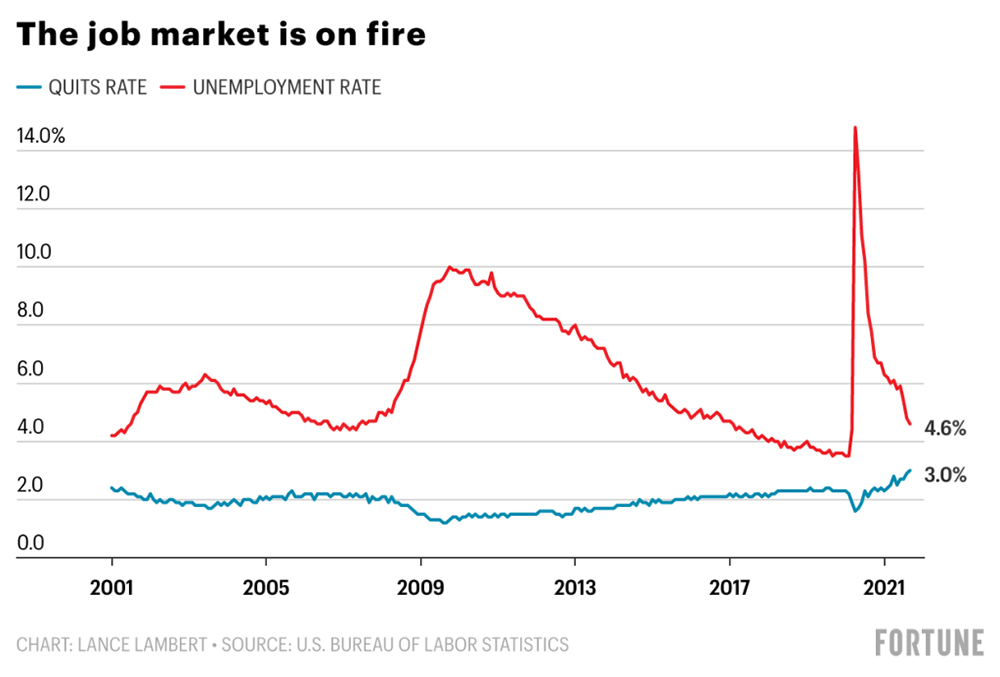大辞职浪潮似乎正愈演愈烈。据美国劳工部(Labor Department)11月12日报道,今年9月有440万人辞职,创下历史新高。
9月的辞职率从8月的高达2.9%提高到3%。8月约有430万人辞职。截至9月底,美国依旧有1040万个职位空缺。
餐饮服务业和零售业的员工流失率最高。9月,餐饮服务业共有86.3万员工离职,零售业有68.5万人离职,辞职率分别为6.6%和4.4%。与此同时,酒店业有98.7万人离职,贸易、交通运输和公用事业等行业有98.4万人离职,医疗保健行业有58.9万人离职。

新冠疫情导致数百万人辞职,进一步加剧了劳动力短缺。这种趋势现在被称为“大辞职浪潮”。虽然现有的职位空缺能够让美国每一位求职者找到一份工作,但据美国劳工统计局(U.S. Bureau of Labor Statistics)的数据显示,截至10月共有740万人没有工作。但《财富》杂志的记者梅根·伦哈特认为,高居不下的辞职率与工作机会的关系不大,而是因为劳动者在新冠疫情之初经历人生剧变等冲击之后,他们所关注的重点发生了变化,还有一些劳动者可能不会重新进入劳动力市场。
September Digital.com对过去六个月辞职的约1250人所做的调查显示,在最近的辞职者中,约44%正在寻找更有竞争力的薪酬和福利。约32%辞职后选择自主创业。而占比62%的大多数人表示,他们之所以辞职是为了更好地掌控自己的生活,做“自己的老板”。还有许多人担心返回办公室办公依旧不安全,而且人们回到办公室办公的动力不足:LinkedIn的数据显示,从4月到7月,员工的工作倦怠现象增加了约9%。
人手短缺是首席执行官们最关注的问题。《财富》杂志10月的调查显示,57%的首席执行官表示,他们最关心“如何吸引和招聘人才”;51%的首席执行官表示他们担心如何留住人才;35%的受访者表示去年为留住人才给员工提供了更多的福利。(财富中文网)
翻译:刘进龙
审校:汪皓
大辞职浪潮似乎正愈演愈烈。据美国劳工部(Labor Department)11月12日报道,今年9月有440万人辞职,创下历史新高。
9月的辞职率从8月的高达2.9%提高到3%。8月约有430万人辞职。截至9月底,美国依旧有1040万个职位空缺。
餐饮服务业和零售业的员工流失率最高。9月,餐饮服务业共有86.3万员工离职,零售业有68.5万人离职,辞职率分别为6.6%和4.4%。与此同时,酒店业有98.7万人离职,贸易、交通运输和公用事业等行业有98.4万人离职,医疗保健行业有58.9万人离职。
新冠疫情导致数百万人辞职,进一步加剧了劳动力短缺。这种趋势现在被称为“大辞职浪潮”。虽然现有的职位空缺能够让美国每一位求职者找到一份工作,但据美国劳工统计局(U.S. Bureau of Labor Statistics)的数据显示,截至10月共有740万人没有工作。但《财富》杂志的记者梅根·伦哈特认为,高居不下的辞职率与工作机会的关系不大,而是因为劳动者在新冠疫情之初经历人生剧变等冲击之后,他们所关注的重点发生了变化,还有一些劳动者可能不会重新进入劳动力市场。
September Digital.com对过去六个月辞职的约1250人所做的调查显示,在最近的辞职者中,约44%正在寻找更有竞争力的薪酬和福利。约32%辞职后选择自主创业。而占比62%的大多数人表示,他们之所以辞职是为了更好地掌控自己的生活,做“自己的老板”。还有许多人担心返回办公室办公依旧不安全,而且人们回到办公室办公的动力不足:LinkedIn的数据显示,从4月到7月,员工的工作倦怠现象增加了约9%。
人手短缺是首席执行官们最关注的问题。《财富》杂志10月的调查显示,57%的首席执行官表示,他们最关心“如何吸引和招聘人才”;51%的首席执行官表示他们担心如何留住人才;35%的受访者表示去年为留住人才给员工提供了更多的福利。(财富中文网)
翻译:刘进龙
审校:汪皓
The Great Resignation appears to be getting worse. In September, 4.4 million people quit their jobs, a record high, the Labor Department reported on November 12.
September's quit rate rose to 3% from its high of 2.9% the previous month, when about 4.3 million people left their jobs. By the end of September, 10.4 million jobs remained open.
The food service and retail industries are shedding workers at the highest rates. A total of 863,000 workers in food service and 685,000 in retail left their jobs in September, at rates of 6.6% and 4.4%, respectively. Meanwhile, 987,000 left hospitality, another 984,000 left trade, transportation, and utilities industries, and 589,000 left health care.
The pandemic has led millions of workers to leave their jobs, in what's being called the Great Resignation, contributing to a growing labor shortage. Although there is a job opening for every American worker looking for employment, 7.4 million are without work as of October, according to the U.S. Bureau of Labor Statistics. But the sky-high number of quits has less to do with job availability than it does with a change in workers’ priorities, after a shock as life-altering as the onset of the pandemic, reports Fortune’s Megan Leonhardt—and some of the workers may not be coming back.
Among those who recently quit, about 44% are looking for more competitive wages and benefits, according to a September Digital.com survey of 1,250 American professionals who left their job in the past six months. About 32% quit to start their own businesses. The majority, 62%, said they quit specifically to have more control over their lives and to be their “own boss.” Many are also concerned that returning to in-person work is still unsafe, and their incentive to do so is limited anyway: Employee burnout increased by almost 9% from April to July, according to LinkedIn.
The labor shortage has been top of mind for CEOs. According to Fortune’s survey in October, 57% of CEOs said they’re most concerned about “attracting and recruiting talent”; 51% said they’re worried about retaining that talent; and 35% reported they’ve offered more benefits in the past year to compensate for the latter.






